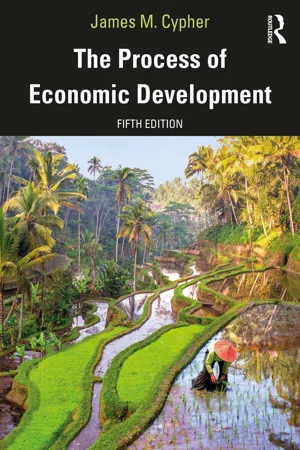
- 740 pages
- English
- ePUB (mobile friendly)
- Available on iOS & Android
The Process of Economic Development
About this book
The fifth edition of The Process of Economic Development offers a thorough and up-to-date treatment of development economics. It has been extensively revised throughout, reflecting the most recent developments in research and incorporating the latest empirical data, as well as key theoretical advances and many new topics. The world has seen vast economic growth in China, economic transformation in India, new challenges in Latin America, rapid economic progress in Southeast Asia, and the deepening impact of environmental issues such as climate change. This new edition addresses all these critical issues as well as the pivotal role of the state, where China's capacity is contrasted with that of African states.
Transnational corporations' reliance on low-wage manufacturing and labor arbitrage is featured in the book. Agricultural policy—extensively explored—remains crucial, as does the promotion of industrialization. This fifth edition offers a 'state-of-the-art' analysis of these essential themes and many others. Numerous case studies and issue focuses have been integrated with sundry central topics. Neoclassical theories and applications, including a timely exploration of behavioral economics, are both rigorously and accessibly explicated.
Cypher's comprehensive account remains the development economics text par excellence, as it takes a much more practical, hands-on view of the issues facing the developing countries than other, overly mathematical texts. This book is unique in its scope and in the detailed attention it gives to a vast range of ideas, including pioneering developmentalist and heterodox formulations. Distinct institutional structures are examined within their historical contexts.
This landmark text will continue to be an invaluable resource for students, teachers, and researchers in the fields of development economics and development studies.
Frequently asked questions
- Essential is ideal for learners and professionals who enjoy exploring a wide range of subjects. Access the Essential Library with 800,000+ trusted titles and best-sellers across business, personal growth, and the humanities. Includes unlimited reading time and Standard Read Aloud voice.
- Complete: Perfect for advanced learners and researchers needing full, unrestricted access. Unlock 1.4M+ books across hundreds of subjects, including academic and specialized titles. The Complete Plan also includes advanced features like Premium Read Aloud and Research Assistant.
Please note we cannot support devices running on iOS 13 and Android 7 or earlier. Learn more about using the app.
Information
Part I
An overview of economic development
Chapter 1
The development imperative
- the development imperative and past-binding structural conditions;
- trends in poverty rates and some of their human and social costs;
- what is meant by inclusive growth;
- the centrality of the Sustainable Development Goals;
- the extent of inequality in the distribution of income and in participation in economic and social life by the world’s poor;
- multidimensional poverty, societal poverty, and the shared prosperity premium;
- the obstacles to development, both internal and external, that tend to thwart economic, social, and human development;
- the significance of fundamental structural change and of technological and institutional innovation to more rapid progress in the future.
Why study development?
Table of contents
- Cover
- Half Title
- Title Page
- Copyright Page
- Table of Contents
- List of illustrations
- Acknowledgments
- List of acronyms
- Introduction
- Part I An Overview of Economic Development
- Part II Theories of Development and Underdevelopment
- Part III The Structural Transformation
- Part IV Problems and Issues
- Index